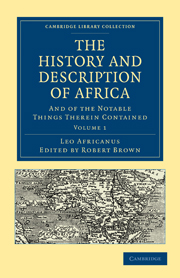Book contents
- Frontmatter
- Contents
- PREFATORY NOTE
- INTRODUCTION
- NORTHERN AFRICA
- BARBARY
- NORTHERN FEZ
- PORY'S MAP OF AFRICA (reduced)
- A GEOGRAPHICAL HISTORIE of AFRICA
- PORY'S DEDICATION TO SIR ROBERT CECIL
- HIS ADDRESS TO THE READER
- HIS GENERAL DESCRIPTION OF AFRICA
- HIS DESCRIPTION OF PLACES UNDESCRIBED BY LEO
- AN APPROBATION OF LEO'S HISTORY BY RICHARD HAKLUYT AND OTHERS
- Notes on Pory's Introductory Matter
- JOHN LEO HIS FIRST BOOK OF THE DESCRIPTION OF AFRICA
- Notes to Book I
HIS GENERAL DESCRIPTION OF AFRICA
Published online by Cambridge University Press: 05 October 2010
- Frontmatter
- Contents
- PREFATORY NOTE
- INTRODUCTION
- NORTHERN AFRICA
- BARBARY
- NORTHERN FEZ
- PORY'S MAP OF AFRICA (reduced)
- A GEOGRAPHICAL HISTORIE of AFRICA
- PORY'S DEDICATION TO SIR ROBERT CECIL
- HIS ADDRESS TO THE READER
- HIS GENERAL DESCRIPTION OF AFRICA
- HIS DESCRIPTION OF PLACES UNDESCRIBED BY LEO
- AN APPROBATION OF LEO'S HISTORY BY RICHARD HAKLUYT AND OTHERS
- Notes on Pory's Introductory Matter
- JOHN LEO HIS FIRST BOOK OF THE DESCRIPTION OF AFRICA
- Notes to Book I
Summary
Africa otherwise called Libya
The greater part of Africa unknown in former ages
That part of inhabited lande extending southward, which we call Africa, and the Greeks Libya, is one of the three generall parts of the world knowen vnto our ancestors; which in very deed was not throughly by them discouered, both bicause the Inlands coulde not be trauailed in regard of huge deserts full of dangerous sands, which being driuen with the winde, put trauailers in extreme hazard of their liues; and also by reason of the long and perilous nauigation vpon the African coasts, for which cause it was by very few of ancient times compassed by nauigation, much lesse searched or intirely known. Of which few, the principall were Hanno a Carthaginian captaine sent by the gouernours of that commonwelth for discouerie of the saide lande, and one Eudoxus that fled from Ptolemœus Lathyrus, the king of Alexandria. Howbeit in these latter times it hath beene often by the Portugals sailed round about, and diligently searched, especially along the shore, euen from the streights of Gibraltar to the enterance of the red sea: but the first Portugall that euer doubled the cape of Buena esperança, and coasted the south and southeast parts of Africa, in former times vnknowne, was Vasco da Gama, in the yeere 1497, who from hence sailed to Calicut in the east Indies, to the vnspeakeable gaine of the Portugals.
- Type
- Chapter
- Information
- The History and Description of AfricaAnd of the Notable Things Therein Contained, pp. 12 - 23Publisher: Cambridge University PressPrint publication year: 2010First published in: 1896



